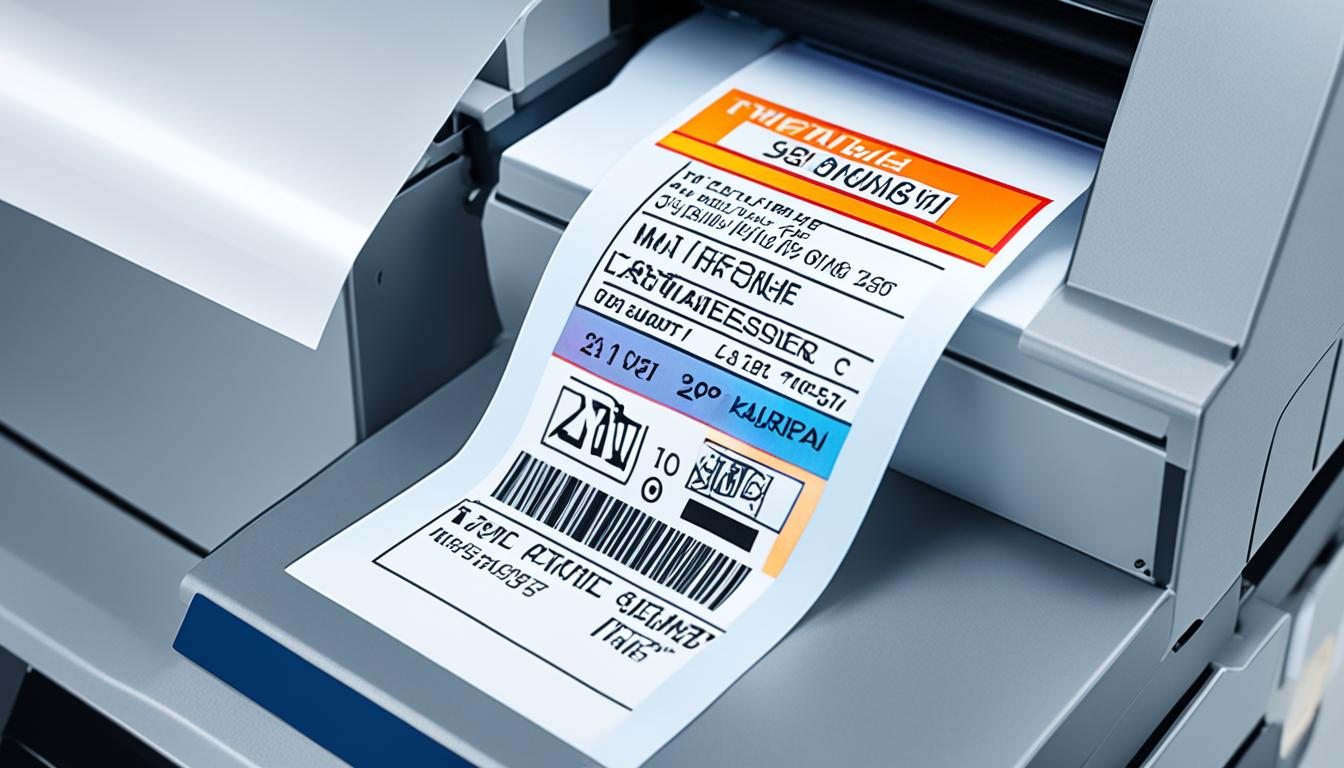Thermal labels are a crucial component in various industries, enabling businesses to print barcodes, labels, and other important information quickly and efficiently. But what exactly are thermal labels, and how do they work?
Thermal labels utilize heat to create images, making them suitable for a wide range of applications. There are two primary print technologies used in thermal printing: direct thermal and thermal transfer.
In direct thermal printing, the heat generated by the printhead causes the label’s surface to mix and turn black, creating the desired image. On the other hand, thermal transfer printing utilizes a thermal ribbon that is heated by the printhead to transfer the image onto the label’s surface.
The choice of label material is another crucial consideration. Paper labels are a versatile and economical option, making them suitable for indoor use and applications with shorter lifecycles. Synthetic labels, on the other hand, offer durability and resistance to abrasion, moisture, and chemicals, making them ideal for outdoor environments and longer label lifecycles.
Key Takeaways:
- Thermal labels use heat to create images quickly and efficiently.
- There are two primary print technologies: direct thermal and thermal transfer.
- Paper labels are versatile and economical, suitable for indoor use and shorter lifecycles.
- Synthetic labels offer durability and resistance to environmental factors, ideal for outdoor environments and longer lifecycles.
Paper Labels: A Versatile and Economical Option
Paper labels are a popular choice for thermal printing applications due to their versatility and cost-effectiveness. Whether you need labels for business or industrial use, paper labels provide a balance between performance and price.
Uncoated paper labels are commonly used in various industries, offering a reliable and economical labeling solution. These labels are suitable for indoor use and have a shorter lifecycle. They provide excellent print quality and are compatible with most thermal printers.
Coated paper labels, on the other hand, are ideal for high-speed volume printing and applications that require enhanced print quality. The coating on the label surface enhances color vibrancy and ensures sharp and clear images. These labels are well-suited for brand labeling, product packaging, and high-visibility applications.
With Zebra’s IQ Color technology, paper labels can achieve impressive color printing results. This innovative technology allows customers to print color on demand using existing Zebra thermal printers, eliminating the need for separate color label printers. This flexibility enables businesses to customize labels and add color coding or branding elements, enhancing overall visual appeal.
| Paper Labels | Uncoated Paper Labels | Coated Paper Labels |
|---|---|---|
| Advantages | – Economical option – Suitable for indoor use – Versatile |
– High-speed volume printing – Enhanced print quality – Ideal for brand labeling and high-visibility applications |
| IQ Color Technology | – Allows color printing on demand using existing thermal printers | |
Whether you need labels for everyday applications or brand labeling, paper labels offer a versatile and cost-effective solution. From uncoated paper labels for general labeling needs to coated paper labels for high-quality and high-impact printing, there is a paper label option to suit your requirements. With the added advantage of Zebra’s IQ Color technology, businesses can achieve impressive color printing while maintaining compatibility with their existing thermal printers.
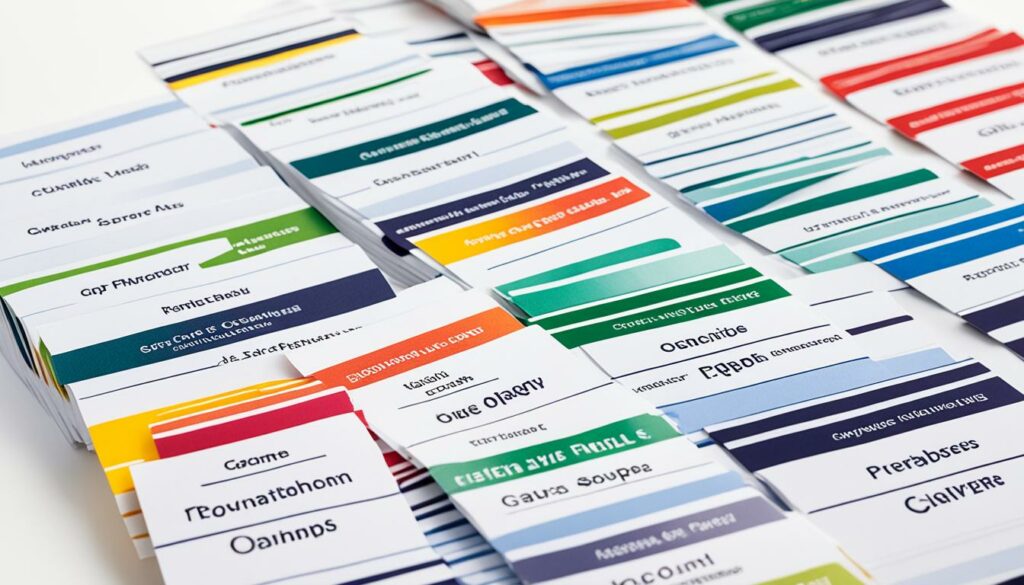
Synthetic Labels: Durable and Resistant to Environmental Factors
When it comes to durability and resistance to environmental factors, synthetic labels are a top choice. These labels are specifically designed to withstand the challenges posed by moisture, abrasion, and chemicals, making them ideal for various applications.
Synthetic labels are made from different types of poly materials, each offering its own unique benefits. The four variations commonly used for synthetic labels are:
- Polyolefin
- Polypropylene
- Polyester
- Polyimide
Polyolefin labels are known for their flexibility, which allows them to conform to curved or rough surfaces. These labels are great for outdoor use with an exposure of up to 6 months.
Polypropylene labels are also flexible and can withstand outdoor exposure for a longer period, ranging from 1 to 2 years. They offer excellent durability and are suitable for applications that require extended label lifecycles.
Polyester labels are designed to withstand high temperatures and can be used outdoors for up to 3 years. These labels are highly resistant to environmental factors, making them a reliable choice for a wide range of applications.
Polyimide labels are specifically recommended for high-temperature applications, such as circuit board labels. These labels can withstand extreme heat and provide excellent performance under challenging conditions.
Choosing the Right Synthetic Label for Your Application
When selecting a synthetic label, it’s important to consider the specific requirements of your application. Factors such as the expected outdoor exposure, surface conditions, and the presence of chemicals should all be taken into account.
Using the right synthetic label ensures that your labels will maintain their integrity and readability, even in harsh environments. Whether you need labels for short-term projects or long-lasting applications, there is a synthetic label material to suit your needs.
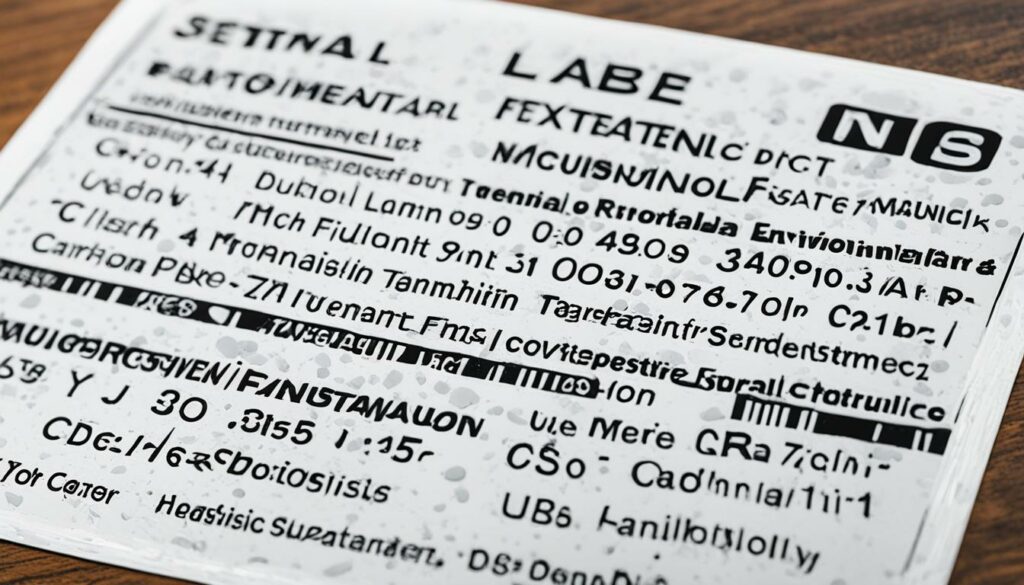
Overall, synthetic labels are a durable and versatile solution for applications that demand resilience. With their resistance to moisture, abrasion, and chemicals, these labels provide long-lasting performance in various industries and environments.
Thermal Printing Technology: Media Configurations and Applications
Thermal printers are designed to work with various media configurations, providing flexibility and versatility for a wide range of applications. Whether it’s die-cut, perforated, or continuous labels, thermal printing technology offers a solution to meet specific printing requirements.
Die-cut labels are a popular choice as they can be easily peeled off and applied to various products and surfaces. They are available in different shapes and sizes, making them suitable for a variety of applications, including product labeling, shipping, and inventory management.
Perforated labels, on the other hand, are designed with small holes along the edges, allowing for easy separation and distribution. They are commonly used for tickets, coupons, and other applications that require tear-off functionality.
Continuous labels, as the name suggests, come in the form of a continuous roll. They provide a cost-effective solution for high-volume printing and are commonly used in applications such as barcode labels, shipping labels, and address labels.
Thermal printers can also print other media types apart from labels. They can handle receipts, tags, ticket stock, and pressure-sensitive labels, expanding their versatility and usability.
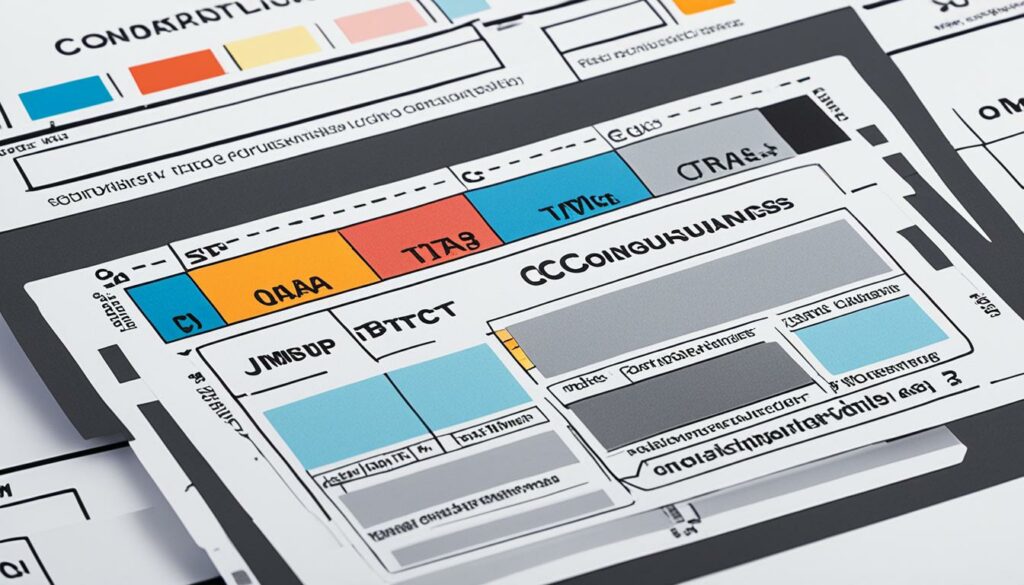
When choosing the right media configuration, it’s important to consider the specific printing requirements and the type of labels needed for the application. Die-cut labels are ideal for precise and professional labeling needs, while perforated labels offer the convenience of easy tear-off. Continuous labels provide an efficient solution for high-volume printing requirements.
With the ability to accommodate various media configurations, thermal printing technology proves to be a versatile solution for a wide range of industries and applications. From retail and manufacturing to logistics and healthcare, thermal printers offer reliable and efficient printing solutions tailored to meet specific needs.
Direct Thermal vs. Thermal Transfer: Choosing the Right Method
Direct thermal printing and thermal transfer printing are two popular print technologies used in the thermal labeling industry. Each method has its own set of advantages and disadvantages, and the choice between the two depends on the specific requirements of the application and the capabilities of the printer.
Direct Thermal Printing:
Direct thermal printing is a simple and cost-effective method that does not require a ribbon. It involves using heat from the printhead to create an image on the label surface. The heat causes the label’s thermal coating to react and produce a visible image. This method is commonly used for short-to-medium-life applications where durability is not a major concern.
Advantages of direct thermal printing:
- Simplicity: It is easy to set up and use. No thermal ribbon is required.
- Cost-effectiveness: With no ribbon or additional supplies needed, direct thermal printing reduces operational costs.
Disadvantages of direct thermal printing:
- Sensitivity to environmental conditions: Direct thermal labels are susceptible to heat, light, and moisture, which can cause fading or degradation of the image over time.
- Limited durability: Labels printed with direct thermal technology have a shorter lifespan compared to thermal transfer labels, making them less suitable for long-term applications.
Thermal Transfer Printing:
Thermal transfer printing, on the other hand, uses a ribbon that is coated with ink or wax/resin. The ribbon is heated by the printhead, and the ink or coating on the ribbon is transferred onto the label material, creating a durable and long-lasting image. This method offers a wider range of print media options and is suitable for applications that require high-quality and long-lasting labels.
Advantages of thermal transfer printing:
- Print media options: Thermal transfer printers can print on a wide variety of materials, including paper, plastic, and synthetic films. This makes it suitable for various applications.
- Durability: The ink or coating transferred onto the label surface in thermal transfer printing provides better resistance to fading, making it suitable for long-life applications.
- Color printing: Thermal transfer printing allows for color printing, giving businesses the flexibility to print labels with vibrant and eye-catching designs.
Disadvantages of thermal transfer printing:
- Cost: Thermal transfer printers require additional supplies such as ribbons, which can increase the overall cost of printing.
- Complexity: Setting up and using thermal transfer printers may require additional knowledge and expertise.
When deciding between direct thermal and thermal transfer printing, businesses should consider the specific requirements of their application, the anticipated label lifespan, and the budget constraints. Direct thermal printing is a cost-effective option for short-to-medium-life applications, while thermal transfer printing offers durability and color options for long-life applications. Consulting with a labeling expert can help businesses make an informed decision based on their unique needs.
| Criterion | Direct Thermal Printing | Thermal Transfer Printing |
|---|---|---|
| Print Technology | Heat from the printhead causes label reaction | Ink or wax/resin transfer from ribbon to label |
| Cost-effectiveness | Cost-effective, no ribbon required | Additional supplies such as ribbons increase costs |
| Durability | Not as durable, susceptible to environmental factors | Durable, resistant to fading and environmental factors |
| Color Options | No color printing | Color printing available |
| Application | Short-to-medium-life labeling | Long-life labeling, outdoor labeling |
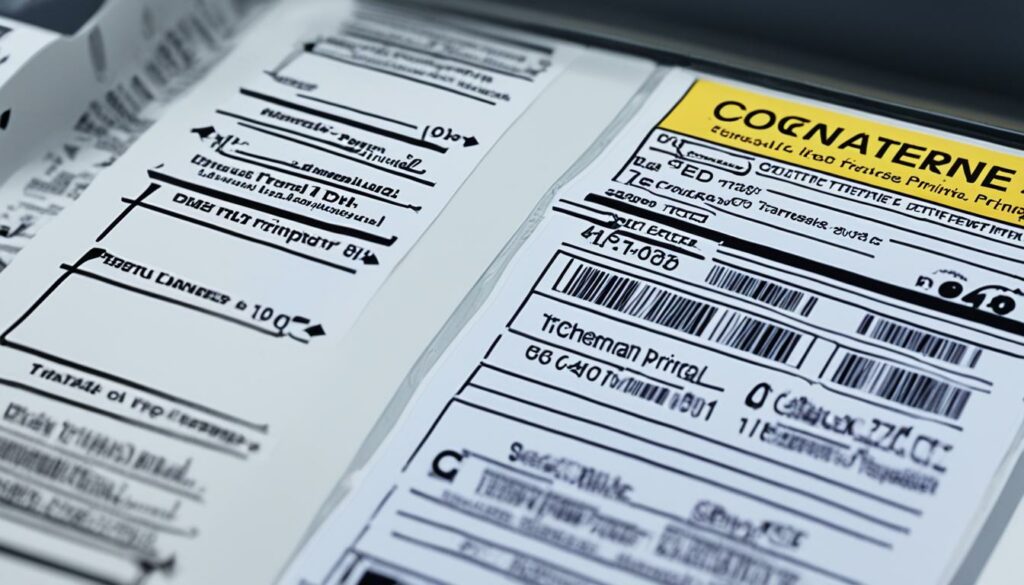
Table: A comparison of direct thermal and thermal transfer printing methods.
Factors Influencing Thermal Label Quality and Longevity
When it comes to thermal-printed labels, quality and longevity are crucial factors to consider. Several elements can affect the durability and lifespan of these labels, including label fading, heat exposure, UV light, and the cost of thermal printers.
Label fading is a common concern for thermal-printed labels, particularly when they are exposed to direct sunlight and high temperatures. Over time, the ink on these labels may fade, potentially compromising important data or records. To preserve label quality and readability, it is important to store them in a controlled environment with room temperature, protecting them from heat, moisture, and sunlight.
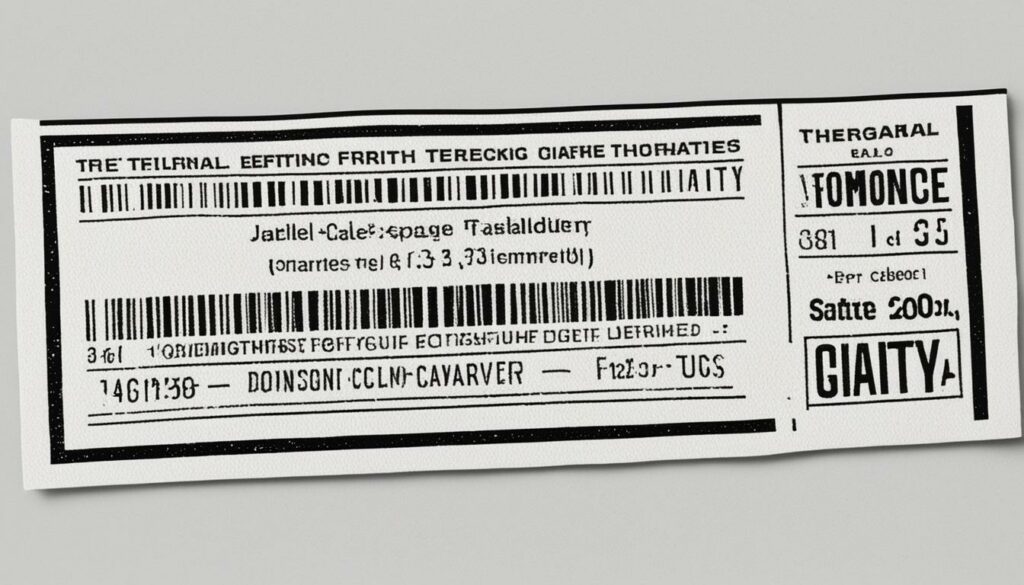
Heat exposure can also have a detrimental impact on thermal labels. Excessive heat can cause the labels to turn completely black, making it impossible to retrieve any information from them. This poses a significant risk for businesses that rely on accurate and legible labels for product identification, traceability, and other purposes.
Additionally, the cost of thermal printers must be taken into consideration. While thermal printers offer numerous benefits, including clear and consistent images, they are generally more expensive than regular inkjet printers. Moreover, thermal printers require specialized parts, which can be costlier to replace.
Overall, to ensure the quality and longevity of thermal labels, it is essential to protect them from heat exposure and UV light, store them in ideal conditions, and carefully consider the cost implications of thermal printers.
Additional Information and Expert Consultation
When it comes to finding the best thermal label solutions for your business, expert consultation is crucial. Label experts have the knowledge and expertise to guide you through the different options and help you make informed decisions to optimize label performance. Whether you need labels for retail, logistics, or healthcare, consulting with the label experts can ensure that you choose the right solutions for your specific needs.
The label experts can discuss your thermal labeling requirements in detail. By understanding your application, they can provide tailored solutions that meet your unique labeling needs. Whether you require high-quality labels for product packaging or durable labels for outdoor use, the experts can recommend the most suitable thermal label options.
Additionally, the label experts can offer valuable advice on the wide variety of label options available, including specialty ribbons and thermal transfer printers. They can provide insights into the different label materials, adhesives, and colors, helping you choose the best combination to achieve your desired results. With their expertise, you can explore the ribbon range and select the most appropriate ribbons for your thermal printing needs.
Choosing the right thermal label solution is essential for optimizing label performance and ensuring customer satisfaction. By consulting with the label experts, you can benefit from their extensive knowledge and experience in the field of thermal labels. They can help you overcome labeling challenges, provide recommendations on the most suitable label materials, and ensure that your labels adhere to industry standards.
For a comprehensive range of thermal label solutions and expert consultation, look no further. Get in touch with the label experts today to discuss your thermal labeling requirements and find the perfect solutions for your business.
Conclusion
Thermal labels are a revolutionary solution for on-demand printing of barcodes, ingredients, and dates. They offer clear and consistent images, making them ideal for various applications. Additionally, thermal labels are compatible with thermal printers, ensuring seamless integration into existing printing systems.
However, there are a few considerations to keep in mind. Over time, thermal labels may experience some fading, especially when exposed to direct sunlight and heat. To maintain label quality and longevity, it’s important to store labels at room temperature and protect them from excessive heat, moisture, and UV light.
Another factor to consider is the higher cost of thermal printers compared to inkjet printers. While thermal printing offers numerous benefits, including efficiency and versatility, businesses need to weigh the upfront investment against their specific needs and budget.
By understanding the different types of thermal labels and their applications, businesses can make informed decisions and optimize their labeling processes. Whether it’s for tracking inventory, improving product identification, or enhancing traceability, thermal labels provide an effective solution for businesses seeking to streamline their labeling operations.
Source Links
- https://www.cdw.com/content/cdw/en/articles/hardware/what-is-a-thermal-printer-how-does-it-work.html
- https://www.zebra.com/ap/en/resource-library/faq/what-are-thermal-labels.html
- https://www.hallylabels.com/labels-blog/understanding-thermal-labels-direct-thermal-vs-thermal-transfer/

Morgan Azhari, the owner of PrinterUpdate.net, is a dedicated expert in the field of printers, leveraging a wealth of experience and education to create a platform that passionately shares insights and solutions.
With a goal to enhance the printer user experience, my vision for the website is to provide valuable content, making a positive impact on individuals navigating the complexities of printers.
